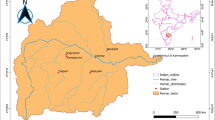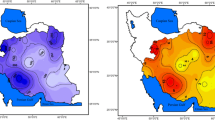Abstract
In the past century, drought events were likely to be frequent and severe in the arid areas under climate change impact. In this study, a Bayesian copula multivariate analysis (BCMA) method is developed for assessing the impact of spatial–temporal variation on drought risk, through coupling Bayesian copula with multivariate analysis. BCMA can reveal the dynamic characteristics of droughts and deal with the uncertainty caused by copula parameters when modeling the dependent structures of variable pairs (duration-severity-affected area). BCMA is applied to the Balkhash Lake basin in Central Asia for assessing multivariate drought risk during 1901–2020. Some major findings can be summarized: (1) in 1901–2020, the basin suffered 53 droughts; the most severe drought occurred from October 1973 to January 1977 (39 months), and 95% of the basin was affected (335,800 km2); (2) droughts usually develop in the direction of “east–west,” and Ili River delta and alluvial plain are the most frequent areas (47.2%) in the basin; (3) droughts show significant seasonality and frequently occur in spring and summer (64.2%), and drought risks of the middle and lower reaches of Ili River are the highest in spring and summer; (4) multivariate characteristics significantly affect drought risk, and drought risk ranges from 1.9 to 18.1% when the guarantee rate is 0.99; (5) the possible causes of drought risk dynamics are meteorological factors (e.g., precipitation and evapotranspiration) and underlying surface factors (e.g., runoff and soil moisture). The findings suggest that droughts in the Balkhash Lake basin are affected by climatic factors, and BCMA can provide methodological support for the studies of drought in other arid regions.
Graphical abstract










Similar content being viewed by others
Data availability
The data sets supporting the results of this study are included in the article.
Code availability
Codes of the MATLAB program are provided in an individual appendix file.
References
Abdi A, Hassanzadeh Y, Talatahari S (2016) Parameter estimation of copula functions using an optimization-based method. Theoret Appl Climatol 129(1–2):1–12
Aizhan U (2020) Save Kazakhstan’s shrinking Lake Balkhash. Science 370(6514):303
Akinwale TO, Phillip GO, David AO (2019) Drought spatiotemporal characterization using self-calibrating Palmer Drought Severity Index in the northern region of Nigeria. Results Eng 3:100088
Anne F, Kerstin S, Giuliano DS (2016) Drought in a human-modified world: reframing drought definitions, understanding, and analysis approaches. Hydrol Earth Syst Sci 20(9):3631–3650
Arbel J, Crispino M, Girard S (2019) Dependence properties and Bayesian inference for asymmetric multivariate copulas. J Multivar Anal 174:104530
Ault TR (2020) On the essentials of drought in a changing climate. Science 368(6488):256–260
Ben E, Matthew G, Boyd H (2019) The social and economic impacts of drought. Aust J Soc Issues 54(1):22–31
Benjamin LH (2012) A spatio-temporal structure-based approach to drought characterization. Int J Climatol 32(3):406–418
Bhatti MI, Do HQ (2019) Recent development in copula and its applications to the energy, forestry and environmental sciences. Int J Hydrogen Energy 44(36):19453–19473
Bohn VY, Raúl R, Varni M (2020) Using SPEI in predicting water table dynamics in Argentinian plains. Environ Earth Sci 79(19):1–16
Chen ZM (2010) An outline of Asia’s geomorphic sphere and its plate morph tectonics. Surveying and Mapping Press, Beijing
Dehghan S, Salehnia N, Sayari N (2020) Prediction of meteorological drought in arid and semi-arid regions using PDSI and SDSM: a case study in Fars province. Iran J Arid Land 12(2):318–330
Diaz V, Perez G, Van LH (2020) An approach to characterize spatio-temporal drought dynamics. Adv Water Resour 137:103512
Duan W, Zou S, Chen Y (2020) Sustainable water management for cross-border resources: the Balkhash Lake basin of Central Asia, 1931–2015. J Clean Prod 263:121614
Dubovyk O, Ghazaryan G, González J (2019) Drought hazard in Kazakhstan in 2000–2016: a remote sensing perspective. Environ Monit Assess 191(8):510
Fatemeh H, Farzad H, Mostafa Y (2021) Evaluation of drought characterization using SPI and SC-PDSI drought indices in baseline and upcoming periods in Birjand region. Arab J Geosci 14(11):939
Guo H, Bao A, Liu T (2018) Spatial and temporal characteristics of droughts in Central Asia during 1966–2015. Sci Total Environ 624:1523–1538
Haario H, Marko L, Antonietta M (2006) Dram: efficient adaptive MCMC. Stat Comput 16(4):339–354
Hamal K, Sharma S, Khadka N (2020) Assessment of drought impacts on crop yields across Nepal during 1987–2017. Meteorol Appl 27(5):1–18
Herrera JE, Satoh Y, Sheffield J (2017) Spatiotemporal dynamics of global drought. Geophys Res Lett 44:2254–2263
Hu ZY, Chen X, Chen DL (2019) “Dry gets drier, wet gets wetter”: a case study over the arid regions of central Asia. Int J Climatol 39(2):1072–1091
Huang GH, Qin XS, He L (2015) Nonstationary desertification dynamics of desert oasis under climate change and human interference. J Geophys Res 120(23):11878–11888
Huang K, Fan YR (2021) Parameter uncertainty and sensitivity evaluation of copula-based multivariate hydroclimatic risk assessment. J Environ Inf 38(2):131–144
Isbekov KB, Tsoy VN, Crétaux J (2019) Impacts of water level changes in the fauna, flora, and physical properties over the Balkhash Lake watershed. Lakes & Reservoirs 24(2):195–208
Jin YF, Yin ZY, Zhou WH (2019) Identifying parameters of advanced soil models using an enhanced transitional Markov chain Monte Carlo method. Acta Geotech 14(6):1925–1947
Li Z, Huang GH, Fan YR (2015) Hydrologic risk analysis for nonstationary streamflow records under uncertainty. J Environ Inf 26(1):41–51
Liu YR, Li YP, Ma Y (2020) Development of a Bayesian-copula-based frequency analysis method for hydrological risk assessment – the Naryn River in Central Asia. J Hydrol 580:124349
Liu YR, Li YP, Yang X (2021) Development of an integrated multivariate trend-frequency analysis method: spatial-temporal characteristics of climate extremes under global warming for Central Asia. Environ Res 195:110859
Liu Z, Zhang X, Fang R (2018) Multi-scale linkages of winter drought variability to ENSO and the Arctic Oscillation: a case study in Shaanxi, North China. Atmos Res 200:117–125
Mellak S, Souag GD (2020) Spatio-temporal analysis of maximum drought severity using copulas in northern Algeria. J Water Clim Change 11:68–84
Montaseri M, Amirataee B, Rezaie H (2018) New approach in bivariate drought duration and severity analysis. J Hydrol 559:166–181
Neisi M, Bijani M, Abbasi E (2020) Analyzing farmers’ drought risk management behavior: evidence from Iran. J Hydrol 590:125243
Nelsen RB (2006) An introduction to copulas. Springer, New York
Palmer WC (1968) An index of agricultural drought. B Am Meteorol Soc 49(3):295
Sadegh M, Ragno E, Aghakouchak A (2017) Multivariate copula analysis toolbox (MvCAT): describing dependence and underlying uncertainty using a Bayesian framework. Water Resour Res 53(6):5166–5183
Sedgwick P (2012) Pearson’s correlation coefficient. BMJ 345:4483–4483
Sheng Y, Paul P, George C (2002) Power of the Mann-Kendall and Spearman’s rho tests for detecting monotonic trends in hydrological series. J Hydrol 259:254–271
Soumia M, Doudja S (2020) Spatio-temporal analysis of maximum drought severity using Copulas in Northern Algeria. J Water Clim Change 11(1):68–84
Vernieuwe H, Baets BD, Verhoest NE (2019) A mathematical morphology approach for a qualitative exploration of drought events in space and time. Int J Climatol 40:1–14
Wang L, Yu H, Yang ML (2019) A drought index: the standardized precipitation evapotranspiration runoff index. J Hydrol 571:651–668
Xu K, Yang DW, Yang HB (2015) Spatio-temporal variation of drought in China during 1961–2012: A climatic perspective. J Hydrol 526:253–264
Yang X, Li YP, Liu YR (2020) A MCMC-based maximum entropy copula method for bivariate drought risk analysis of the Amu Darya River Basin. J Hydrol 590:125502
Yue P, Lee H (2020) Drought-induced spatio-temporal synchrony of plague outbreak in Europe. Sci Total Environ 698:134138
Zger M, Baakn EE, Ekmekciolu M (2020) Comparison of wavelet and empirical mode decomposition hybrid models in drought prediction. Comput Electron Agric 179:105851
Zhang YM, Li YM, Shen GM (2013) Plant resources and utilization in Central Asia. China Meteorological Press, Beijing
Zhang DJ, Lin QY, Yao HX (2021) Accelerating SWAT simulations using an in-memory NoSQL database. J Environ Inf 37(2):142–152
Zhao H, Gao G, An W (2017) Timescale differences between sc-PDSI and SPEI for drought monitoring in China. Phys Chem Earth 102:48–58
Acknowledgements
The authors are grateful to the editors and the anonymous reviewers for their insightful comments and suggestions.
Funding
This research was supported by the Strategic Priority Research Program of the Chinese Academy of Sciences (XDA20060302).
Author information
Authors and Affiliations
Contributions
X. Yang: conceptualization, methodology, data collection, writing original draft, writing review and editing. Y. P. Li: supervision, writing review and editing, project administration, and funding acquisition. G. H. Huang: modifying the manuscript and polishing English. S. Q. Zhang: data collection, graph editing, and reference checking.
Corresponding author
Ethics declarations
Ethics approval
Not applicable.
Consent to participate
Not applicable.
Consent for publication
Not applicable.
Conflict of interest
The authors declare no competing interests.
Additional information
Publisher's note
Springer Nature remains neutral with regard to jurisdictional claims in published maps and institutional affiliations.
Highlights
• A BCMA method is developed for analyzing multivariate drought risk.
• BCMA can reveal the static and dynamic characteristics of droughts.
• BCMA can handle the uncertainty caused by copula parameters.
• Droughts show significant seasonality and directionality.
• Meteorological factors are the key reason that brings the drought risk.
Appendix (Method details)
Appendix (Method details)
MATLAB program for self-calibrating PDSI extraction and visualization.
Step 1: Model sample data
-
1.
ncdisp('H:\Global\PDSI\scPDSI.cru.3.25.bams2018.GLOBAL.1901.2017.nc');
-
2.
data1=ncread('H:\Global\PDSI\scPDSI.cru.3.26.bams2018.GLOBAL.1901.2017.nc','scpdsi');
-
3.
data3=data1(:,:,1);
-
4.
data4=rot90(data3);
-
5.
data5=flipud(data4);
-
6.
data5(isnan(data5))=-999;
-
7.
dlmwrite('sample_1.txt',data5,'\t',1,1)
Step 2: Add latitude and longitude information to sample_1.txt
-
1.
ncols 720
-
2.
nrows 360
-
3.
xllcorner -180
-
4.
yllcorner -90
-
5.
cellsize 0.5
-
6.
NODATA_value -999
Step 3: Rasterize the sample_1.txt by ASCII code in ArcGIS, and output it as sample_1.tif
Step 4: Load a raster file with projection information, and define the projection on the example_1.tif
Step 5: Batch processing
-
1.
[aaaaa,R]=geotiffread('H:\Global\PDSI\example_1.tif');
-
2.
info=geotiffinfo('H:\Global\PDSI\example_1.tif');
-
3.
data=ncread('H:\Global\PDSI\scPDSI.cru.3.26.bams2018.GLOBAL.1901.2017.nc','scpdsi');
-
4.
for year=1901:2017
-
5.
data1=data(:,:,1+12*(year-1901):12*(year-1900));
-
6.
data3=sum(data1,3)/12;
-
7.
data4=rot90(data3);
-
8.
data5=flipud(data4);
-
9.
filename=strcat('H:\Global\PDSI\yearly_pdsi\global',int2str(year),'yearly_PDSI.tif');
-
10.
geotiffwrite(filename, data5, R, 'GeoKeyDirectoryTag', info.GeoTIFFTags.GeoKeyDirectoryTag);
-
11.
for mon=1:12
-
12.
data2=data1(:,:,mon);
-
13.
data4=rot90(data2);
-
14.
data5=flipud(data4);
-
15.
filename=strcat('H:\Global\PDSI\monthly_pdsi\global', int2str(year), '_', int2str(mon), 'monthly_PDSI.tif');
-
16.
geotiffwrite(filename, data5, R, 'GeoKeyDirectoryTag', info.GeoTIFFTags.GeoKeyDirectoryTag);
-
17.
end
-
18.
end
Rights and permissions
About this article
Cite this article
Yang, X., Li, Y.P., Huang, G.H. et al. Analyzing spatial–temporal change of multivariate drought risk based on Bayesian copula: Application to the Balkhash Lake basin. Theor Appl Climatol 149, 787–804 (2022). https://doi.org/10.1007/s00704-022-04062-z
Received:
Accepted:
Published:
Issue Date:
DOI: https://doi.org/10.1007/s00704-022-04062-z




